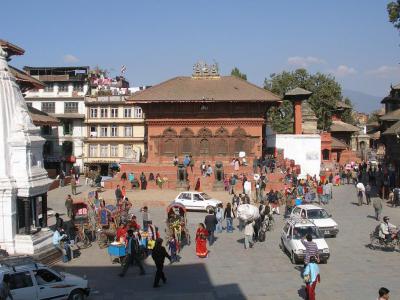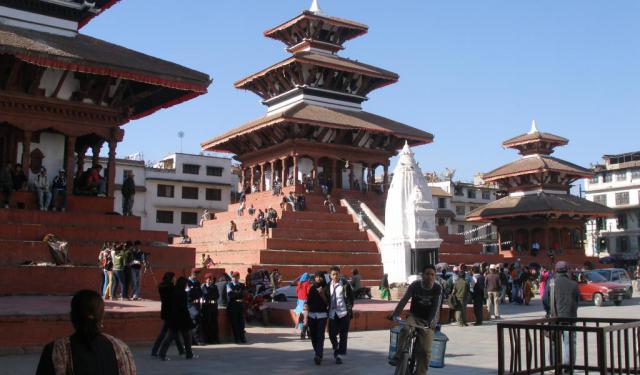
Durbar Square, Kathmandu (must see)
Durbar Square is a royal palace complex in Kathmandu. The square's full name is Hanuman Dhoka Durbar Square, named after the statue of Hanuman, a Hindu god, situated at the entrance.
The first royal palaces were constructed during the third century. Due to repeat reconstruction, nothing is left of those first buildings. Several structures around Durbar Square collapsed in 2015 when a 7.9 magnitude earthquake struck the region. The oldest building destroyed was the 7th-century Kasthamandap, a three-storied temple enshrining the deity of Gorakhnath.
It is thought that the existing palaces were built in the 10th century by Gunakamadeva, the ruler who founded the city of Kathmandu. They were not declared royal palaces until sometime during the reign of King Ratna Malla in the late 15th or early 16th century. The Durbar Square was the center of power until 1896 but continues to be used for coronations.
Structures around the complex include the 16th-century temples of Jagannath, Kotilingeshwara, Mahadev, Mahendreshwara, and Taleju. Other temples are the 18th-century Bhagavati Temple and the 17th-century Degutale Temple.
The Gaddi Durbar Neoclassical Palace was built in Durbar Square in 1908. It was designed in European architectural style with Greek columns and white plaster. The palace was used for coronations and to welcome heads of state from other countries. The Kumari Chock, a red-colored royal palace at the southern end of Durbar Square, is an even more popular attraction. It consists of the Raj Kumari or the Living Goddess, a preadolescence girl in a gilded cage, thought to be the human incarnation of the goddess Durga.
The Hanuman Dhoka Palace is open to visitors. Tourists can see the staterooms and the museums. The two museums inside the Hanuman Dhoka Palace are the King Tribhuvan Memorial Museum and the Mahendra Museum.
Durbar Square is a UNESCO World Heritage Site.
The first royal palaces were constructed during the third century. Due to repeat reconstruction, nothing is left of those first buildings. Several structures around Durbar Square collapsed in 2015 when a 7.9 magnitude earthquake struck the region. The oldest building destroyed was the 7th-century Kasthamandap, a three-storied temple enshrining the deity of Gorakhnath.
It is thought that the existing palaces were built in the 10th century by Gunakamadeva, the ruler who founded the city of Kathmandu. They were not declared royal palaces until sometime during the reign of King Ratna Malla in the late 15th or early 16th century. The Durbar Square was the center of power until 1896 but continues to be used for coronations.
Structures around the complex include the 16th-century temples of Jagannath, Kotilingeshwara, Mahadev, Mahendreshwara, and Taleju. Other temples are the 18th-century Bhagavati Temple and the 17th-century Degutale Temple.
The Gaddi Durbar Neoclassical Palace was built in Durbar Square in 1908. It was designed in European architectural style with Greek columns and white plaster. The palace was used for coronations and to welcome heads of state from other countries. The Kumari Chock, a red-colored royal palace at the southern end of Durbar Square, is an even more popular attraction. It consists of the Raj Kumari or the Living Goddess, a preadolescence girl in a gilded cage, thought to be the human incarnation of the goddess Durga.
The Hanuman Dhoka Palace is open to visitors. Tourists can see the staterooms and the museums. The two museums inside the Hanuman Dhoka Palace are the King Tribhuvan Memorial Museum and the Mahendra Museum.
Durbar Square is a UNESCO World Heritage Site.
Want to visit this sight? Check out these Self-Guided Walking Tours in Kathmandu. Alternatively, you can download the mobile app "GPSmyCity: Walks in 1K+ Cities" from Apple App Store or Google Play Store. The app turns your mobile device to a personal tour guide and it works offline, so no data plan is needed when traveling abroad.
Durbar Square on Map
Sight Name: Durbar Square
Sight Location: Kathmandu, Nepal (See walking tours in Kathmandu)
Sight Type: Attraction/Landmark
Guide(s) Containing This Sight:
Sight Location: Kathmandu, Nepal (See walking tours in Kathmandu)
Sight Type: Attraction/Landmark
Guide(s) Containing This Sight:
Walking Tours in Kathmandu, Nepal
Create Your Own Walk in Kathmandu
Creating your own self-guided walk in Kathmandu is easy and fun. Choose the city attractions that you want to see and a walk route map will be created just for you. You can even set your hotel as the start point of the walk.
Pashupatinath Temple Complex Tour
Pashupatinath Temple Complex in Kathmandu is a sacred religious site that holds great significance for Hindus worldwide. The area in which it is located, near the Tribhuvan International Airport, is truly picturesque - surrounded by virgin jungle. This complex encompasses several notable locations, each contributing to its spiritual and cultural importance.
At the heart of the complex stands... view more
Tour Duration: 1 Hour(s)
Travel Distance: 1.8 Km or 1.1 Miles
At the heart of the complex stands... view more
Tour Duration: 1 Hour(s)
Travel Distance: 1.8 Km or 1.1 Miles
Kathmandu's Street Markets Tour
Ardent shoppers – those keen on street markets in particular – will find Kathmandu a true heaven. In this city, street markets are where you can buy some exotic (and often good-quality) products, such as monk's robes, soft silks, woolen garments, artifacts, and more, at very good prices. The list of bargains is truly endless. Sadly, however, in Kathmandu, you are not allowed to buy... view more
Tour Duration: 1 Hour(s)
Travel Distance: 2.2 Km or 1.4 Miles
Tour Duration: 1 Hour(s)
Travel Distance: 2.2 Km or 1.4 Miles
Kathmandu Introduction Walking Tour
Kathmandu is the capital city of Nepal. With nearly 3 million residents in the metropolitan region, Kathmandu is also the largest city in the country. Kathmandu is notable for being one of the oldest continuously inhabited cities in the world.
The name "Kathmandu" comes from the name of the Kasthamanadap pavilion in Durbar Square. That name comes from the Sanskrit words for... view more
Tour Duration: 2 Hour(s)
Travel Distance: 2.9 Km or 1.8 Miles
The name "Kathmandu" comes from the name of the Kasthamanadap pavilion in Durbar Square. That name comes from the Sanskrit words for... view more
Tour Duration: 2 Hour(s)
Travel Distance: 2.9 Km or 1.8 Miles



